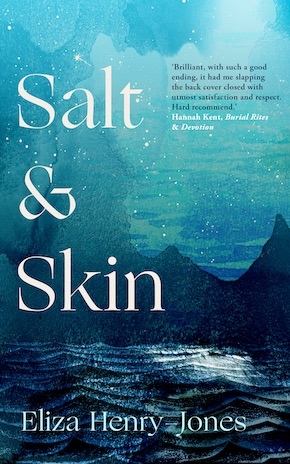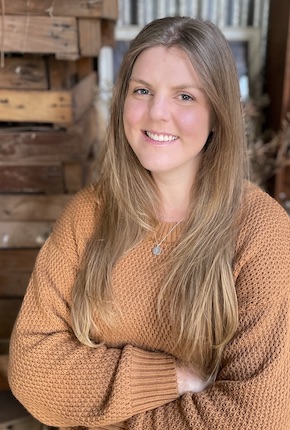Trials, trauma and women’s tales
by Eliza Henry-Jones
In winter 2017, I visited a sandstone cathedral in Orkney called St Magnus. I’d published two novels in as many years, with the next about to be released, and I was exhausted. This trip was meant to be a break from creating – I’d even left my laptop at home in Australia.
I wandered the aisles of the kirk, watching an artist silently sketching the long line of tombstones that line the walls, their hand quick and certain across the blank page. St Magnus is where many of those accused of witchcraft during the 17th century witch-hunts were imprisoned, kept in a high-up dungeon known as Marwick’s Hole. Marwick’s Hole is still there, its floor once shaped like the bottom of a champagne bottle so that those imprisoned could not rest or dream. The double hangman’s ladder they climbed at nearby Gallow’Ha is also at the kirk. I stood in front of the ladder, looking at those old, old rungs. Why, I wanted to know. And who. And that was the moment I knew I wanted to write Salt and Skin.
I became increasingly fascinated by the Orkney witch trials, by the fractured records detailing the trials and everyday lives of the accused. Even more, I was fascinated by what existed in the spaces between what was known – the stories that were never recorded, or not preserved. I was struck by how many women had been accused of having power over the biggest things in our world; over life and death; over the weather and the seasons and things that grow in the earth. How does this idea of the witch hunts, and women’s voices, intersect with climate change? How do we make sense of places like St Magnus Cathedral, where histories both violent and domestic are so densely layered on top of each other?
I didn’t start working on Salt and Skin until more than a year after my trip to Orkney. By then, I’d published a fourth novel and had had my first child – a little boy who’s now four. He had reflux, and spent a lot of time in those early months sleeping on top of me. While I normally start writing pretty quickly when the idea for a novel starts to cohere, I couldn’t physically get both hands free to type on a keyboard. As the days passed in a delirious blur of feeding and napping and rocking, I considered the pieces of the story I wanted to tell. I spent so long considering the story without writing anything down, that the idea began to feel huge and impenetrable. The more I thought about what I wanted the story to be – something about witches and witch marks and selkies and ghosts; something about family and love and trauma and climate change and the sea, threaded through with warmth and levity – the less I felt like I was able to actually start it. I couldn’t find my way in.
One night, after the 3 a.m. feed, I pulled out my phone and I began to write verse down in the notes app of my phone. Snippets of what I wanted the novel to be – scenes that beat to a different rhythm to the novel scenes I was used to. This different rhythm allowed me to find my way into the story. I wrote about 4,000 words that night, and those 4,000 words formed the scaffolding from which I wrote Salt and Skin. The final lines from that strange verse poem ended up being, almost word for word, the final paragraph of the finished version of Salt and Skin. During an editing process where I discarded over 150,000 words, somehow that fragment remained – guiding the direction of the narrative. That fragment of verse was like a shoreline visible from a turbulent and unsettled sea, keeping me certain of where I needed to get to.
My reality, both in my own life and as a clinician, has been of trauma evading narrative. People who’ve experienced trauma may not be able to string the events into something that makes sense.”
Before my first book came out, I worked with families in the drug and alcohol sector. Studying psychology at university, I was drawn to the field of addiction, and to trauma studies. Trauma is something I have always ended up examining in my work. How do we make sense of it? More so – how do we write about it, when trauma so often exists in a space without words? For me, trauma almost exists in a similar way to the gaps in the records from the witch trials. A wordless, active absence that impacts the present.
There’s a pattern I’ve often noticed playing out in novels – including some of my own. The pattern is this: we, the readers, are introduced to a character. It’s hinted that they have a traumatic backstory – something horrific and painful that would explain why they act the way they do. Readers are curious creatures – we want to know. There is often a build-up towards a climax where this character finally articulates their traumatic story to someone else in the story, achieving a sort of catharsis and healing, which I’ve not really witnessed in real life.
My reality, both in my own life and as a clinician, has been of trauma evading narrative. People who’ve experienced trauma may not be able to string the events into something that makes sense, let alone pull the experience together coherently enough to share with someone else. So often, trauma remains present but unspoken, and this was something I was determined to portray in Salt and Skin. It’s hinted early on that Darcy, a bright and awkward teenage boy from Australia, has a traumatic past. Through fragmented scenes and seemingly innocuous memories, the reader can piece together what happened to him. Darcy never articulates his experiences – not to himself, not to anyone else. Despite never telling anyone, there is a sense that he is still held, and seen and loved – that even if he never tells anyone what he’s been through, he will survive, he will be lived, and that his life is still wide open before him, full of possibility.
Writing Salt and Skin challenged me more than anything else I’ve ever written. It was daunting and exhilarating and a little bit scary, and I know the characters will stay with me (whether I want them to or not).
—

Eliza Henry-Jones is a writer and academic based on a flower farm in the Yarra Valley of Victoria, Australia. Her previous novels have been listed for multiple literary awards and her work has been published in the Guardian, Country Style, The Big Issue and The Age. She has qualifications in psychology as well as grief, loss and trauma counselling. Salt and Skin was published in Australia and New Zealand by Ultimo Press in 2022, and is now published in the UK and North America by September Publishing.
Read more
elizahenryjones.com.au
@elizahenryjones
@septemberbooks
Read an extract from Salt and Skin: Catastrophe on the shore

